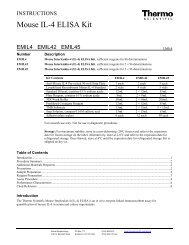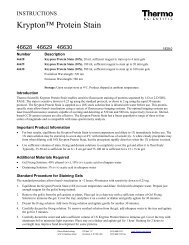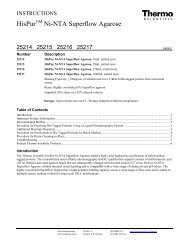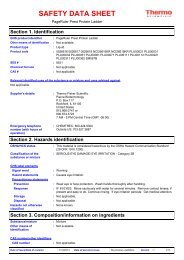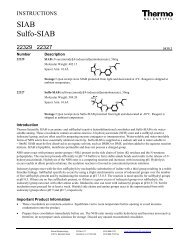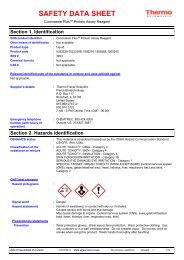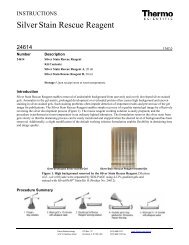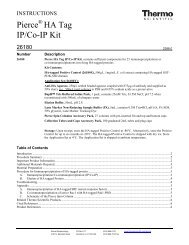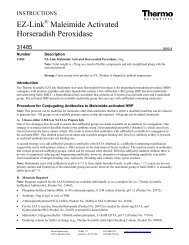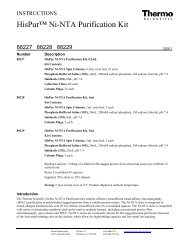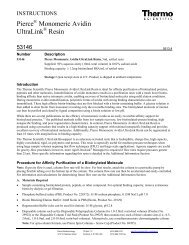Thermo Scientific Pierce Protein Assay Technical Handbook Version 2
Thermo Scientific Pierce Protein Assay Technical Handbook Version 2
Thermo Scientific Pierce Protein Assay Technical Handbook Version 2
You also want an ePaper? Increase the reach of your titles
YUMPU automatically turns print PDFs into web optimized ePapers that Google loves.
Specialty <strong>Assay</strong>s – Histidine-tagged <strong>Protein</strong>s<br />
Histidine-tagged <strong>Protein</strong> Detection<br />
<strong>Thermo</strong> <strong>Scientific</strong> HisProbe-HRP Western blotting probe takes<br />
advantage of the affinity of histidine for the Ni 2+ cation.<br />
A. B.<br />
HisProbe-HRP is a nickel (Ni 2+ )-activated derivative of horseradish<br />
peroxidase (HRP). This product has been optimized for<br />
direct detection of recombinant histidine-tagged proteins and<br />
other histidine-rich proteins. The active ligand is a tridentate<br />
chelator that allows Ni 2+ to be bound in active form for subsequent<br />
interaction and detection of target molecules. The active<br />
chelator has similar binding capabilities to that reported for<br />
iminodiacetic acid, which has long been used for immobilized<br />
metal affinity chromatography (IMAC).<br />
Highlights:<br />
• Yields lower background than anti-histidine antibodies<br />
• <strong>Pierce</strong> HRP is a high-activity enzyme<br />
• Stripping and reprobing is possible<br />
• HisProbe-HRP (Ni 2+ ) can be used for detection of<br />
histidine-tagged proteins<br />
Substrate<br />
Signal<br />
Ni 2+<br />
Ni 2+ HRP Ni 2+<br />
HisHisHisHisHisHis<br />
6His<br />
<strong>Protein</strong><br />
Detection of histidine-tagged fusion proteins with <strong>Thermo</strong> <strong>Scientific</strong><br />
HisProbe-HRP.<br />
Ordering Information<br />
Product Description Pkg. Size<br />
15165 HisProbe-HRP 1mg<br />
15168 SuperSignal ® West Pico HisProbe Kit<br />
Includes: HisProbe-HRP<br />
SuperSignal West Pico<br />
Chemiluminescent Substrate<br />
BSA in TBS (10X)<br />
BupH Tris Buffered Saline Packs<br />
Surfact-Amps ® 20 (10%)<br />
Kit<br />
2mg<br />
500mL<br />
1 x 125mL<br />
10 x 500mL<br />
6 x 10 ampules<br />
Panel A using <strong>Thermo</strong> <strong>Scientific</strong> HisProbe-HRP shows high specific binding<br />
and low background.<br />
Panel B using anti-polyHis failed to recognize two of the three fusion proteins.<br />
References<br />
Adler, J. and Bibi, E. (2004). Determinants of substrate recognition by the Escherichia<br />
coli multidrug transporter MdfA identified on both sides of the membrane. J. Biol.<br />
Chem. 279, 8957-8965.<br />
Adler, J. and Bibi, E. (2005). Promiscuity in the geometry of electrostatic interactions<br />
between the Escherichia coli multidrug resistance transporter MdfA and cationic<br />
substrates. J. Biol. Chem. 280, 2721-2729.<br />
Boulant, S., et al. (2003). Unusual multiple recoding events leading to alternative forms<br />
of hepatitis C virus core protein from genotype 1b. J. Biol. Chem. 278, 45785-45792.<br />
Kanaya, E., et al. (2001). Zinc release from the CH 2 C 6 zinc finger domain of filamentous<br />
flower protein from Arabidopsis thaliana induces self-assembly. J. Biol. Chem. 276,<br />
7383-7390.<br />
Robalino, J., et al. (2004). Two zebrafish eIF4E family members are differentially<br />
expressed and functionally divergent. J. Biol. Chem. 279, 10532-10541.<br />
Robichon, C., et al. (2005). Depletion of apolipoprotein N-acyltransferase causes<br />
mislocalization of outer membrane lipoproteins in Escherichia coli. J. Biol. Chem. 280,<br />
974-983.<br />
Segawa, H., et al. (2005). Reconstitution of GDP-mannose transport activity with purified<br />
Leishmania LPG2 protein in liposomes. J. Biol. Chem. 280, 2028-2035.<br />
Sundberg-Smith, L., et al. (2005). Adhesion stimulates direct PAK1/ERK2 association and<br />
leads to ERK-dependent PAK1 Thr212 phosphorylation. J. Biol. Chem. 280, 2055-2064.<br />
Wagner, C., et al. (2005). Dimerization of NO-sensitive guanylyl cyclase requires the α1<br />
N terminus. J. Biol. Chem. 280, 17687-17693.<br />
Wann, E., et al. (2000). The fibronectin-binding MSCRAMM FnbpA of Staphylococcus<br />
aureus is a bifunctional protein that also binds to fibrinogen. J. Biol. Chem. 275,<br />
13863-13871.<br />
32<br />
For more information, or to download product instructions, visit www.thermoscientific.com/pierce



